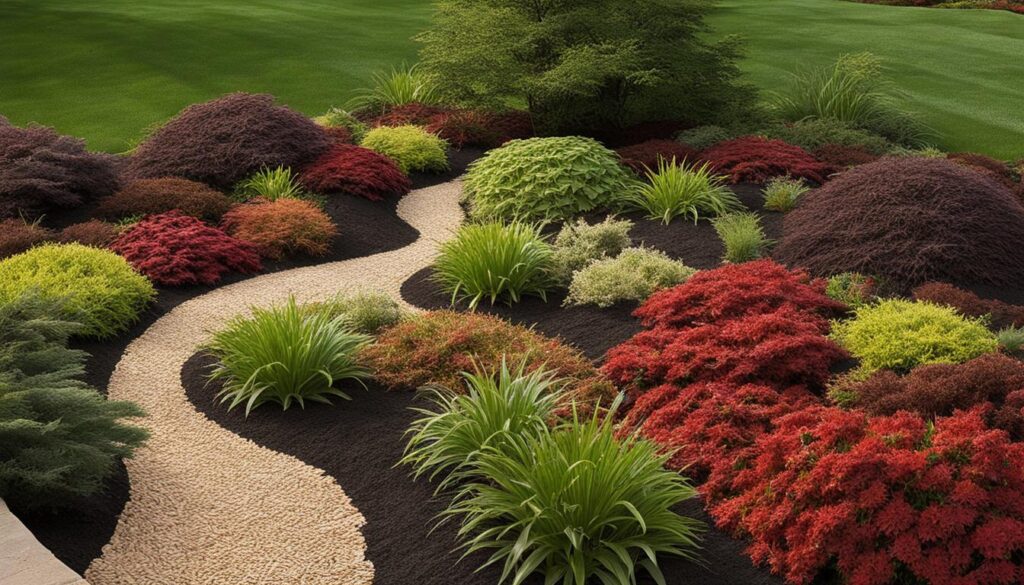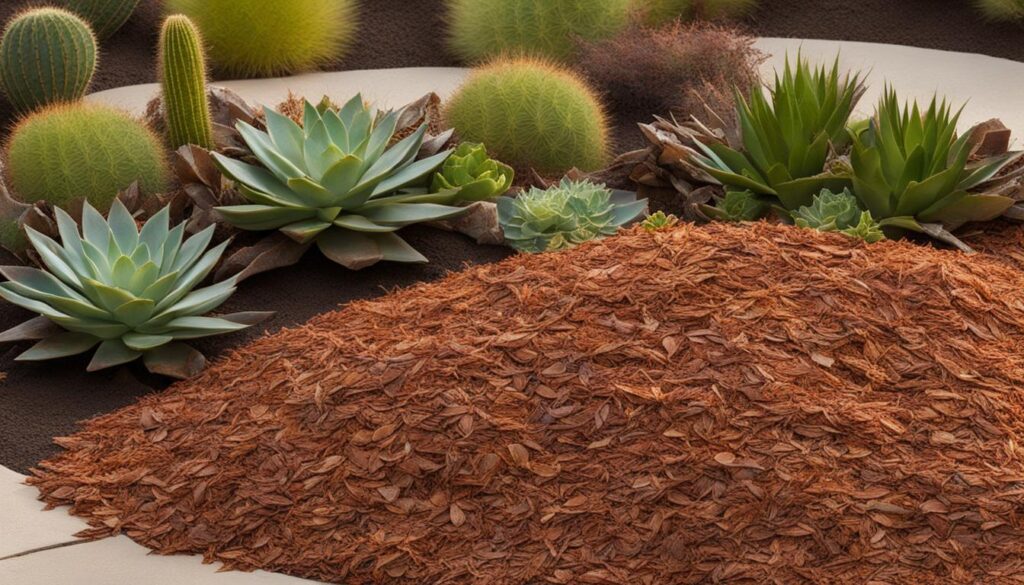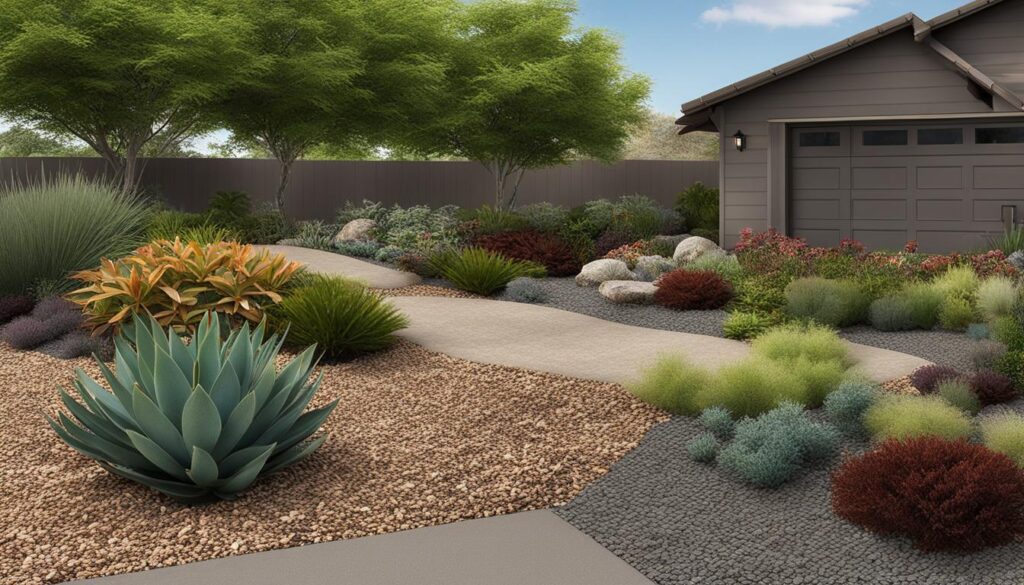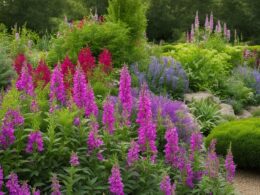Are you looking for the perfect mulch options to enhance your xeric landscape? Mulch is a versatile material that not only improves soil health but also retains moisture and prevents weed growth. With various organic and inorganic options available, you can choose the right mulch to meet the specific needs of your xeric landscape.
Key Takeaways:
- Mulch is essential for improving soil health, retaining moisture, and preventing weed growth in xeric landscapes.
- There are two main types of mulch: organic and inorganic, each offering unique benefits.
- Organic mulches, such as bark, wood chips, and compost, provide nutrients and are suitable for improving soil health.
- Inorganic mulches, like pebbles and stones, offer long-lasting weed control and temperature regulation.
- By choosing the right mulch option, you can conserve water, promote plant health, and create a visually appealing xeric landscape.
Understanding Mulch: Types and Uses
Mulch is a layer of material applied to the soil surface to enhance soil fertility, regulate temperature, retain moisture, and prevent weed growth. There are two main types of mulch: organic and inorganic. Organic mulches, such as bark, wood chips, and straw, provide nutrients to the soil as they decompose and are suitable for improving soil health in xeric landscapes. On the other hand, inorganic mulches, such as pebbles and stones, offer long-lasting weed control and temperature regulation. Understanding the different types of mulch and their uses is essential for choosing the right option for your xeric landscape.
“Organic mulches, such as bark, wood chips, and straw, provide nutrients to the soil as they decompose and are suitable for improving soil health in xeric landscapes.”
When it comes to organic mulches, bark mulch is commonly used for its aesthetic appeal and weed suppression properties. It adds a natural and visually pleasing element to xeric landscapes while keeping unwanted weeds at bay. Wood chip mulch, on the other hand, is ideal for ornamental landscaping and providing nutrients to flower or vegetable gardens. Its ability to break down slowly makes it a long-lasting option for improving soil health.
Inorganic mulches, such as pebbles and stones, offer their own set of benefits in xeric landscapes. These mulches provide excellent weed control and help regulate soil temperature without the need for frequent replacement. Pebble and stone mulches can be used to create visually appealing designs and add an elegant touch to xeric landscapes. Their durability and low-maintenance nature make them a practical choice for areas where moisture retention is not a priority.
Inorganic Mulch Options for Xeric Landscapes
If you’re considering inorganic mulch for your xeric landscape, you have several options to choose from. River rock and lava rock are popular choices due to their natural appearance and ability to retain heat, making them ideal for arid climates. Fabric mulch is another practical option as it helps reduce weed growth and prevents erosion. It is often used in areas where plants are still establishing themselves or in hardscape areas like walkways or patios.
Understanding the different types of mulch and their uses is crucial in making informed decisions for your xeric landscape. Whether you opt for organic or inorganic mulch, each offers unique benefits that can help improve soil health and reduce maintenance requirements. Consider the specific needs of your landscape, such as water conservation, weed control, and aesthetic appeal, to select the most suitable mulch option.
| Mulch Type | Benefits | Suitability |
|---|---|---|
| Organic (Bark, Wood Chips, Straw) | Nutrient-rich, improves soil health | Xeric landscapes with soil improvement goals |
| Inorganic (Pebbles, Stones) | Long-lasting weed control, temperature regulation | Xeric landscapes with low maintenance needs |
| Inorganic (River Rock, Lava Rock) | Natural appearance, heat retention | Arid climates |
| Inorganic (Fabric) | Weed control, erosion prevention | Establishing plants or hardscape areas |
Understanding the different types of mulch and their uses is crucial in making informed decisions for your xeric landscape. By selecting the right mulch option, you can enhance soil health, conserve water, and create a visually appealing outdoor space that requires minimal maintenance.
Organic Mulch Options for Xeric Landscapes
When it comes to xeric landscapes, organic mulch options offer a range of benefits. They not only help retain moisture in the soil but also improve soil health and prevent weed growth. Here are some popular organic mulch options to consider:
Bark Mulch
Bark mulch is a commonly used organic mulch for xeric landscapes. It not only adds aesthetic appeal to your outdoor space but also acts as a natural barrier against weeds. The slow decomposition of bark mulch ensures that it retains its effectiveness for a longer time.
Wood Chip Mulch
If you have ornamental landscaping or flower and vegetable gardens, wood chip mulch is an ideal option. It not only provides nutrients to the soil but also helps regulate soil temperature. Wood chip mulch is available in different sizes and can add a beautiful texture to your xeric landscape.
Compost Mulch
For those looking for an eco-friendly option, compost mulch is worth considering. It replenishes the soil with nutrients, aids in moisture retention, and promotes plant growth. Compost mulch is an excellent choice for improving the overall health of your xeric landscape.
Remember to consider the specific needs of your xeric landscape when choosing an organic mulch option. Each type offers unique benefits, so choose the one that aligns with your goals and preferences.
| Mulch Option | Benefits | Suitability |
|---|---|---|
| Bark Mulch | Provides aesthetic appeal, weed suppression | General xeric landscapes |
| Wood Chip Mulch | Provides nutrients, regulates soil temperature | Ornamental landscaping, flower/vegetable gardens |
| Compost Mulch | Replenishes soil, promotes plant growth | General xeric landscapes |
Inorganic Mulch Options for Xeric Landscapes
Inorganic mulches are an excellent choice for xeric landscapes due to their low-maintenance nature and long-lasting benefits. These mulches, such as pebbles, stones, river rock, lava rock, and fabric, offer effective weed control and temperature regulation, making them ideal for areas where moisture retention is not a priority. Let’s explore some of the popular inorganic mulch options and their characteristics:
Table 1: Comparison of Inorganic Mulch Options for Xeric Landscapes
| Mulch Option | Appearance | Weed Control | Temperature Regulation | Erosion Control |
|---|---|---|---|---|
| Pebbles | Natural colors and smooth texture | Effective weed suppression | Good temperature regulation | Provides stability to slopes |
| Stones | Various sizes and shapes | Excellent weed control | Offers moderate temperature regulation | Prevents soil erosion |
| River Rock | Smooth and rounded stones | Effective weed suppression | Provides moderate temperature regulation | Reduces soil erosion |
| Lava Rock | Porous and lightweight | Good weed control | Offers excellent temperature regulation | Enhances water drainage |
| Fabric | Available in various colors | Prevents weed growth | Minimal temperature regulation | Effective erosion control |
As shown in Table 1, pebbles and stones provide effective weed control and temperature regulation, making them versatile options for xeric landscapes. River rock offers similar benefits but also helps in reducing soil erosion. Lava rock, with its porous nature, enhances water drainage while providing excellent weed control and temperature regulation. Fabric mulch, although not as effective in temperature regulation, offers efficient weed control and erosion control. Consider the aesthetic appeal, functionality, and specific requirements of your xeric landscape to select the most suitable inorganic mulch option.
Inorganic mulches, such as pebbles and stones, can add a touch of elegance to your xeric landscape design while providing long-lasting benefits. Their low-maintenance nature allows you to enjoy a visually appealing outdoor space without extensive upkeep. By investing in inorganic mulch options, you can create a sustainable and beautiful xeric landscape that requires minimal water usage and maintenance.
Remember, the choice between organic and inorganic mulches ultimately depends on your specific needs and goals for your xeric landscape. Inorganic mulches excel in areas where moisture retention is not a priority but weed control and temperature regulation are necessary. Take the time to assess your landscape’s requirements and explore different inorganic mulch options to create an aesthetically pleasing and sustainable outdoor space.
Benefits of Mulching in Xeric Landscapes
Mulching in xeric landscapes offers numerous benefits that contribute to the health and sustainability of your outdoor space. By understanding and harnessing these benefits, you can create a vibrant and resilient landscape that thrives in arid conditions.
Retains Moisture and Reduces Water Evaporation
One of the primary advantages of mulching in xeric landscapes is its ability to retain moisture in the soil. Mulch acts as a protective barrier, preventing water from evaporating quickly and allowing it to penetrate deep into the ground. This is especially beneficial in regions with limited water resources, as it helps to conserve water and reduce the frequency of irrigation.
In addition to retaining moisture, mulch also helps to regulate soil temperature. It acts as an insulating layer, keeping the soil cooler in hot weather and warmer during colder periods. This temperature regulation helps to protect the roots of plants from extreme heat or cold, providing a more favorable environment for their growth and development.
Natural Weed Control and Soil Health Improvement
Mulch serves as a natural weed barrier, suppressing weed growth by blocking sunlight and preventing weed seeds from germinating. This reduces the need for manual weed removal and minimizes competition for nutrients and water between weeds and desirable plants.
Furthermore, organic mulches, such as bark, wood chips, and compost, gradually decompose over time, enriching the soil with essential nutrients. This decomposition process improves soil health, enhances fertility, and promotes the growth of beneficial microorganisms. As a result, plants in xeric landscapes can access the nutrients they need for optimal growth and resilience.
Enhances Aesthetics and Reduces Maintenance
In addition to its functional benefits, mulch also adds visual appeal to xeric landscapes. By choosing the right type and color of mulch, you can create a cohesive and attractive design that complements the overall aesthetics of your outdoor space.
Moreover, mulching can significantly reduce the need for ongoing maintenance. By preventing weed growth, mulch minimizes the time and effort required for weed control. It also helps to prevent soil erosion, reducing the risk of nutrient loss and preserving the integrity of your landscape.
Overall, the benefits of mulching in xeric landscapes are numerous. Whether you choose organic or inorganic mulch, taking advantage of its ability to retain moisture, control weeds, improve soil health, regulate temperature, and enhance aesthetics can result in a thriving and sustainable outdoor space.
Design Ideas for Xeric Landscapes
When creating a xeric landscape, incorporating mulch can add both functionality and visual interest to your outdoor space. Here are some design ideas that can help you make the most of mulch in your xeric landscape:
- Focus on Mulch: Consider creating a garden that is predominantly mulch with a few carefully chosen drought-tolerant plants. This design approach not only reduces water usage but also minimizes maintenance requirements.
- Use Mulch to Define Areas: Utilize different types or colors of mulch to define or separate various areas of your landscape. This can help create visual boundaries and highlight specific features or zones within your xeric garden.
- Combine Mulch with Native Plants: Incorporate native plants, perennials, and annuals into your xeric landscape design along with mulch. This combination adds color, texture, and diversity to your outdoor space while maintaining water conservation principles.
- Create Seating Areas and Pathways: Utilize mulch to create seating areas and pathways within your xeric landscape. Mulch provides a comfortable and visually appealing surface while adding a natural touch to your outdoor living space.
“Incorporating mulch in xeric landscapes can save water, reduce maintenance, and add aesthetic appeal.” – Landscape Design Expert
Design Inspiration
For inspiration, look for xeric landscape designs that successfully incorporate mulch as a focal point. Consider the placement of mulch in relation to drought-tolerant plants, rocks, or other hardscape elements. Experiment with different mulch types, colors, and arrangements to find the combination that best enhances the overall look and feel of your xeric landscape.
| Benefit | Design Idea |
|---|---|
| Water Conservation | Create a mulch-dominant garden |
| Visual Boundaries | Use mulch to define areas |
| Color and Texture | Combine mulch with native and ornamental plants |
| Comfort and Aesthetics | Create seating areas and pathways with mulch |
What Are the Best Mulch Options for Xeric Landscapes?
When it comes to creating a xeric landscape, it’s essential to consider master xeric garden mulching strategies. Some of the best mulch options for xeric landscapes include gravel, pebbles, and wood chips. These choices can help conserve water, control weeds, and protect the soil in drought-prone environments.
Conclusion
In conclusion, when it comes to mulch options for xeric landscapes, you have a variety of choices to consider. Both organic and inorganic mulches offer unique benefits and can be tailored to meet the specific needs of your outdoor space.
Organic mulches, such as bark, wood chips, and compost, are excellent for improving soil health, retaining moisture, and suppressing weeds. They provide nutrients as they decompose, creating a fertile environment for your plants. On the other hand, inorganic mulches like pebbles, stones, and fabric offer long-lasting weed control and temperature regulation. They require less maintenance and can enhance the visual appeal of your xeric landscape.
By understanding the different mulch options available and their advantages, you can make informed decisions to create a beautiful and sustainable xeric landscape. Experiment with different mulch types, colors, and arrangements to find the perfect combination that suits your design goals and ecological needs. With the right mulch, you can conserve water, promote plant health, and create an aesthetically pleasing outdoor space for years to come.













